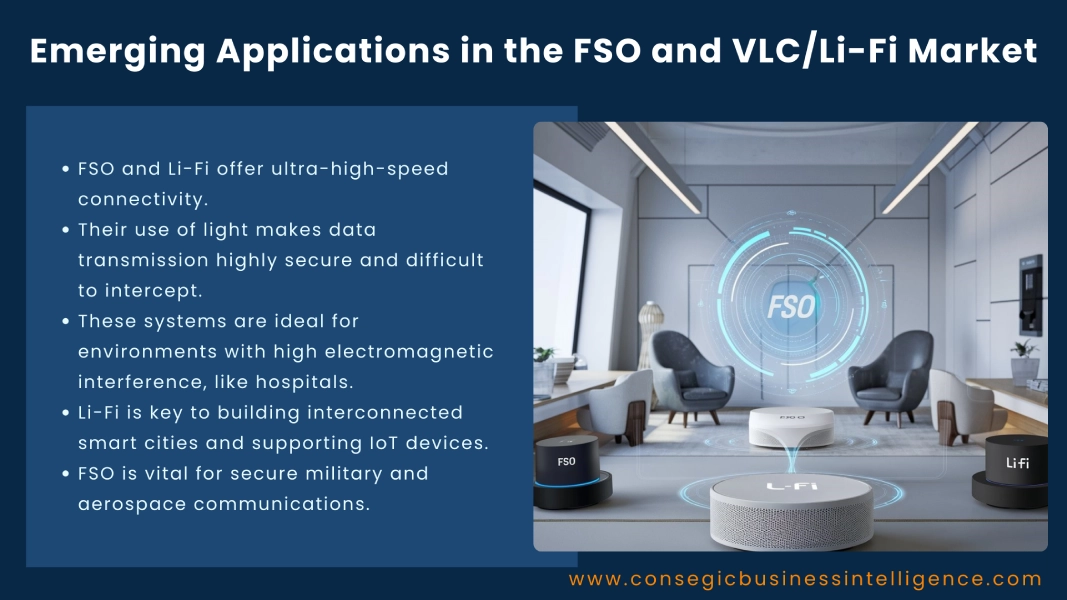Emerging Applications in the FSO and VLC/Li-Fi Market
Free Space Optics (FSO) and Visible Light Communication (VLC), also known as Li-Fi, are two fast-growing technologies that are redefining the way data is transmitted. Unlike traditional radio-frequency communication, these systems use light waves, infrared for FSO and visible light for VLC/Li-Fi to enable high-speed, secure, and interference-free connections. As demand for faster, more reliable, and spectrum-efficient communication grows worldwide, FSO and Li-Fi are gaining traction in diverse industries.

The global FSO and VLC/Li-Fi market is seeing a wave of innovative use cases that highlight the flexibility and potential of these optical communication technologies. Below mentioned are emerging applications driving adoption and growth across sectors.
- 5G Backhaul and Network Densification
One of the most critical applications for FSO is in 5G backhaul. As mobile operators deploy dense networks of small cells, traditional fiber installation becomes expensive and time-consuming. FSO provides a cost-effective, flexible alternative for connecting base stations in urban areas. Furthermore, its high bandwidth and quick deployment capabilities make it an ideal solution for accelerating 5G rollouts in both developed and developing markets.
- Smart Cities and Intelligent Infrastructure
Li-Fi is finding growing use in smart cities where streetlights, traffic systems, and public Wi-Fi points can double as data transmission hubs. By embedding VLC transmitters into lighting infrastructure, municipalities can provide high-speed internet access in public spaces while also supporting data-intensive applications like traffic management, surveillance, and environmental monitoring. This integration reduces costs and maximizes the utility of existing infrastructure.
- Defense and Secure Communications
FSO is highly valued in defense and military applications for its secure, line-of-sight communication. Since light beams are difficult to intercept without physical access, they offer better protection against eavesdropping compared to RF signals. Militaries are exploring FSO for tactical battlefield communications, drone-to-ground links, and ship-to-ship data exchange. Similarly, Li-Fi is being tested in secure indoor communications where RF interference or interception poses risks.
- Aviation and In-Flight Connectivity
Airlines are increasingly turning to VLC/Li-Fi as an alternative to traditional in-flight Wi-Fi. By integrating Li-Fi transmitters into cabin lighting, airlines can deliver high-speed internet to passengers without the bandwidth constraints of satellite links. Beyond entertainment, Li-Fi can also support crew communications and aircraft data transfer, improving operational efficiency. This application is gaining momentum as carriers seek to differentiate passenger experiences.
- Underwater and Marine Communication
Radio waves attenuate quickly in water, making traditional wireless communication ineffective in marine environments. VLC and FSO are emerging as strong alternatives for short-to-medium-range underwater communication. These systems are being applied in submarine-to-submarine data exchange, underwater drone communication, and oceanographic research, where fast and reliable links are essential. This market segment is particularly important for naval operations and scientific missions.
- Healthcare and Hospital Networks
Li-Fi is emerging as a preferred communication method in hospitals, where reducing electromagnetic interference is critical. Traditional Wi-Fi signals can interfere with sensitive medical devices, but Li-Fi provides a safe, high-speed alternative using visible light. Hospitals are exploring Li-Fi-enabled lighting systems to deliver connectivity in patient rooms, operating theaters, and diagnostic areas. Beyond connectivity, this application ensures compliance with strict healthcare safety standards.
- Industrial IoT and Smart Manufacturing
Factories and industrial environments require reliable, interference-free communication for connected sensors, robotics, and automated systems. Li-Fi and FSO are being adopted in smart manufacturing environments to enable Industrial IoT. By embedding Li-Fi into LED lighting or using FSO for connecting industrial control systems, companies can achieve high-speed data transfer while avoiding electromagnetic interference that can disrupt critical equipment.
- Education and Indoor High-Speed Connectivity
Educational institutions are increasingly adopting Li-Fi to improve connectivity in classrooms, libraries, and labs. By turning LED lighting into data access points, schools and universities can deliver high-speed, secure connections to students and faculty. Li-Fi not only enhances digital learning but also reduces RF congestion in environments with a high density of connected devices. This application is expected to grow as digital education expands globally.
Conclusion
The FSO and VLC/Li-Fi market is rapidly evolving with a wide range of applications that highlight the unique strengths of light-based communication. From 5G backhaul and smart city infrastructure to defense, aviation, underwater communication, healthcare, industrial IoT, and education, these technologies are unlocking new possibilities across industries. Their ability to provide secure, high-capacity, and interference-free communication positions them as critical enablers of the next generation of connectivity.
As global demand for faster and more reliable data transmission grows, the adoption of FSO and Li-Fi is set to accelerate, making them integral to the digital infrastructure of the future.
